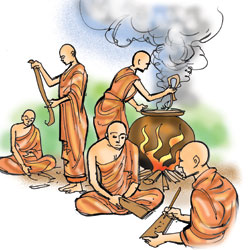| King Ravulu Vijayaba | ||
This article is part of a continuing series on the ‘Mahavamsa,’ the recorded chronicle of Sri Lankan history | ||
| By Halaliye Karunathilake Edited and translated by Kamala Silva Illustrated by Saman Kalubowila | ||
1. The modern town of Kandy, which was really 'Senkadapura,' had its beginning during the time of King Parakramabahu IV. It was called 'Siriwardanapura' at that time. Asgiri hermitage in Kandy also began during this time. It was 1312 A.D., then. It is on the invitation of this king, that the 'Jata kattha kathawa,' was translated into Sinhala as the 'Pansiya Panas Jathaka Potha.' Books like 'Dalada Siritha' and 'Bodhivamsa' were written under this king's patronage.
2. It is during this period that Rev. Vilgammula Sangharaja, too lived. It is stated that Parakramabahu IV ruled till 1336 A.D. but nothing definite is available about his last days. There is evidence to say that there was a rebellion in Kurunegala, towards the end of his rule. This king has ruled for 24 years. Buwanekabahu III succeeded him. He is well known as Vanni Buwanekabahu. 3. This king's period of rule was 6 years. We do not come across any important events connected to this king. He was succeeded by Vijayabahu V, who was also known as 'Ravulu Vijayaba.' He was the last ruler of Kurunegala. From here begins the Gampola period. Buwanekabahu IV, was the first king of the Gampola period. 4. It may be due to troubles from the North, that the kingdom had to be changed from Kurunegala to Gampola. By this time kingship too, had been changed to another line of kings. Scholars believe that the leadership of the northern areas too, would have undergone change by this time. The Arab 5. The ruler in the North, at that time was Aryachakravarthi. The ruler of Rameshwaran too happened to be an Aryachakravarthi. Therefore it is believed that the Aryachakravarthi of the North, would have accepted Pandya supremacy. However, either Arychakravarthi or a ruler who preceded him, would have changed the line of kings before
6. In an inscription which belongs to 1360 A.D., there is mention of an Aryachakravarthi and he as, 'Ravulupathi' - which means the leader of 'Ravulu' people. The areas over which their power spread, were known to the Sinhala people as, Javaka provinces. 'Ravulu' and 'Javaka' seem to be words having a similar meaning. Scholars point out that the word 'Ravulu,' is derived from Javaka, according to Telegu usage. 7. The period when Aryachakravarthi was powerful in the North, the royal families of the Sinhala people were also named 'Ravulu.' They would have used this name as they came from the Javaka area in the North. In one of the Pali texts, written during this period, King Vijayabahu V- Savulu, is described as belonging to the line of Parakramabahu. Here the mention is to Parakramabahu I. He too belonged to the Kalinga dynasty. 8. Javakas are also described as Kalingas. It is with pride that the Kalinga kings, who ruled in Polonnaruwa, claim that they are descendents of the generation of Sri Vijayaraja. This has led |
The Triple Gem ! A Buddhist site With Dhamma, Sanga, by , Priyantha De silva,"The Future Global Education Center", Hittatiya East, Matara, sri Lanka. A Dhamma links, Bana , Sermons, Online Buddhist TV , buddhist radio stations links,You are very important to us with your participation to this blog.Make creative Ideas that will fetch others to highest place of Nibbana !That mean Ultimate Happiness. May Lord Buddha Bless You ! May The Triple Gem Bless you !
Sunday, July 27, 2008
King Ravulu Vijayaba
Subscribe to:
Post Comments (Atom)



1 comment:
He was a great king..
Post a Comment